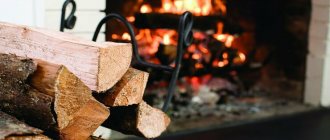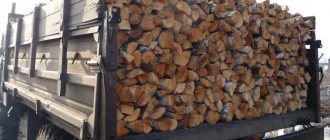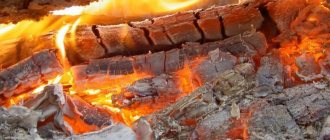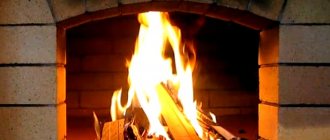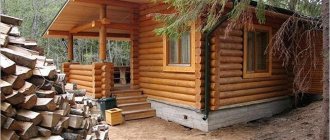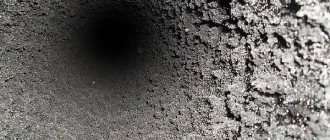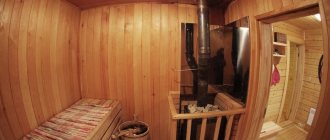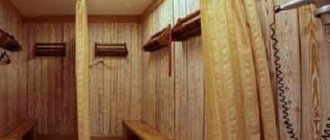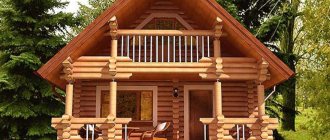The most important characteristics of firewood
Good, high-quality firewood should have the following properties:
- high flammability;
- high heat transfer;
- low ash content;
- low or medium smoke.
All these parameters depend on two factors - the condition of the firewood and the type of wood from which they are prepared. Regardless of what kind of firewood is used in a stove or solid fuel boiler, be it in a house or in a bathhouse, it must be dry.
GarryFORUMHOUSE Member
The stove or fireplace should be heated with air-dried logs with a maximum humidity of 15-25%. Only then will they burn without releasing aggressive substances and effectively provide heat.
The calorific value of firewood varies depending on the type of wood, but even logs of the same type will produce different amounts of heat in dry and wet states. With a humidity of 50%, and for freshly cut wood it can be up to 95%, the specific heat of combustion of a kilogram of firewood is one and a half times lower. Therefore, after harvesting, which necessarily includes chopping logs, the logs are stored in the woodshed for drying. On average, this process takes about two years, but some species dry faster due to the lower moisture content of the wood (birch, ash). If necessary, they can be heated raw, but still not necessary. How much firewood is needed for a season or a year directly depends on the calorific value, and it is still lower for wet ones, therefore, the consumption will be higher. The drying time is also affected by the harvesting season - in any winter firewood the initial humidity is minimal.
Video description
See the video for what improper storage leads to:
For fireplaces and pyrolysis stoves, it is advisable to further dry the fuel by keeping it in a warm and dry place for several days. The “cleaning” firewood – aspen and alder, used for cleaning chimneys – should also be well dried.
It is advisable to harvest oak in advance and put it into use after a year or two - this is the time it takes for the wood to dry. Birch, on the contrary, is used in the year of purchase. Linden is stored for no longer than 2-3 years if you want to enjoy its amazing aroma in the bathhouse.
Wood species for firewood
If you take dry logs of different types, they differ in the intensity of combustion, and in the amount of heat generated, and in the amount of smoke produced and ash remaining after combustion. The calorific value of wood and its flammability are based on density - the denser the structure, the longer it burns and the greater the amount of heat generated. Which firewood will be better in terms of minimal ash content and low smoke production depends on its mineral composition and the presence of resins.
Coniferous species, with the exception of larch, are characterized by low-density wood and strong resinity, which is why they burn very quickly, emit little heat, and produce a lot of soot. Pine wood produces more heat than spruce, but still less than harder types, and when long-burning firewood is needed, they choose anything but coniferous. Plus, pine logs are not suitable for open fireplaces - when burned, due to the bursting resinous pockets, sparks fly in different directions. But coniferous wood also contains essential oils, which is why it is used as fuel for baths or used for kindling. And for the home, if coniferous firewood is the most accessible, it is worth heating with it, especially when the stove is cold or damp. The main species harvested for firewood are deciduous trees – both “wild” and fruit trees. The latter are especially relevant for smokehouses, as they produce aromatic smoke when burned. To prepare the famous Peking duck, the Chinese not only feed the poultry in a special way, but also use exclusively firewood from fruit trees in the process. To understand which kind of firewood is better in all respects, let’s look at deciduous wood.
The main stages of lighting a stove
Previously, the ability to heat a bathhouse was called a real art. To be able to heat your own bathhouse no worse than a professional bathhouse attendant, you need knowledge of the rules of how to heat a wood-fired bathhouse and a little practice. It doesn’t hurt to know which stove is best for a bathhouse and how to heat it correctly.
So, how to properly heat a stove in a bathhouse? First, the steam room must be in perfect order. All items that are not used during the steaming process should be removed from the sauna, all debris should be removed and the floor should be thoroughly washed. The shelves must be washed with an antiseptic using a brush. It is also necessary to wash the walls and ceilings of the premises. Then you should open all the windows and doors and let the room ventilate.
After cleaning, you can start heating the stove. All furnaces have their own characteristic features, so the heating will also have its own characteristics. But there are basic points that are the same for all types of stoves. Failure to follow the rules of kindling can lead to tragic consequences, such as fumes, heat stroke, and fire. Let's look at how to properly heat a stove in a bathhouse with wood.
This process consists of the following steps:
- Preparation.
- Kindling.
- Loading firewood.
- Completion of the heating of the bath.
Next, we will consider step by step how to properly heat a sauna with an iron stove.
Birch firewood
Birch belongs to the category of medium-density wood (550-740 kg/m³), and its ash content varies between 2.43-0.52%. In terms of the amount of heat generated, birch firewood is in the leader group, since the average density is combined with initially lower, and in a dry state, minimal humidity and the presence of tar in the wood composition. However, this carbon compound contributes not only to rapid ignition and intense combustion, but also to increased smoke production with a lack of draft. If you use wet logs and the draft is insufficient, tar will settle on the walls of the chimney. When it is not possible to store and dry a woodpile for a year, but you need to select and heat it in real time, birch will become a real help. The main thing is to ensure good draft so that the wood burns on fire and does not smoke. But for pyrolysis boilers, professionals do not recommend using either wet or dry birch firewood; in this case, other species will be better. Birch bark or splinters are considered the preferred materials for lighting a stove, even if other firewood is of poorer quality.
Preparation
Using a scoop, remove ash and unburnt coals from the stove into any suitable container. They can simply be thrown away or used as fertilizer for plants.
Then you need to add firewood and, for safety reasons, place it away from the firebox.
Next, the stones are prepared. If a closed heater is installed, then they must be rinsed to remove soot. If the open-type heater and steam room have already been used, then the stones need to be washed again. To do this, take warm water.
If the bathhouse does not have a full-fledged washing room with a shower, then the following steps should be taken: check the water tank (if installed) for the presence of a sufficient amount of water, prepare cool water for washing.
It is important to remember that the water boiler connected to the stove must always be filled, even if warm water will not be used. The fact is that the boiler can simply burst due to strong exposure to high temperatures.
If the steam room is a separate room with a door, then it should be closed. Next, the doors and valves at the combustion chamber, blower and smoke view are fully opened. If there are two valves in the design of the smoke view, it is necessary to open the one through which fire and smoke directly exit into the pipe; the valve of the heating channel for the water tank and heater does not need to be opened.
The presence of draft is checked: a match or candle is lit and brought to the stove channel. The flame will certainly respond to the pull. If there is no reaction, then there is a high probability that the chimney is clogged. In this case, it is necessary to climb onto the roof and, using a special device, for example, a cleaning cable of the required length, remove the blockages.
It is necessary to prepare the following materials:
- Birch bark. It needs to be cut into thin pieces. To do this, you can use a sharp knife. Instead, you can take shavings or chop short chips.
- Newsprint.
- 4 logs. They should be dry and small in diameter (about the same thickness). The firewood must be of such a size that it can be easily inserted into the stove firebox.
Next is the “seed”:
- Two thin logs are placed parallel to each other on the grate. The distance between them should be equal to the width of your palm. The logs should be placed immediately behind the first vent holes from the ash pit.
- The paper is crumpled and placed between the logs.
- A little wood chips are poured on top of the paper.
- The two remaining logs are laid diagonally on top, leaving a small gap between them.
As a result, the paper and wood chips should end up in a well of logs. The resulting structure must be stable enough not to collapse due to careless actions.
Oak
If once upon a time alder firewood was considered royal, today the “crown” has passed to oak wood, due to its outstanding properties.
- First density category (750 kg/m³ and more).
- The first category of heat capacity (200-300 kcal).
- Long burning.
When the question arises as to what type of wood is best for heating not only the stove, but also the fireplace, oak wood often wins over others due to the characteristic odor released during combustion. In open fire conditions, this is both pleasant and useful, since aromatization occurs due to the presence of essential oils in the wood. But not everyone will allow themselves to use only oak logs for full-fledged stove heating, since they belong to the upper price segment. You can prepare some of them to put at night or in other cases when you need the longest burning possible. And the bulk of the time is heated with wood with good heat transfer, but from types that are more accessible to a wide range of people. The quality of oak firewood depends on the age of the tree - the older it is, the worse it is; it is recommended to harvest logs from trunks of medium age and size. Due to its high density, even dry oak burns quite slowly and very reluctantly. For kindling, it is more effective to use flammable resinous rocks, dried bark or birch bark.
How to ensure drying
Firewood, which is offered in abundance by trading companies, is dried in special chambers or under the influence of an electric field. This process requires expensive equipment; it is not possible to carry it out at home. But a few recommendations will help you cope with this problem and dry the firewood yourself:
- the sides of the woodshed should be left open, so the logs can quickly ventilate and dry if they get wet (relevant for a structure with a roof);
- when placing the woodshed outdoors, you should cover its upper part with roofing felt or thick film;
- It is necessary to stack the firewood correctly, only then, even with high humidity, will it be able to dry.
Alder
Alder wood is the most beautiful and if you choose from an aesthetic point of view, logs of rich orange, ocher or almost red color will become an excellent decor near the stove. In terms of the amount of heat generated, alder belongs to the second, middle group, although its density is at the level of the third (up to 540 kg/m³). Like birch, the high calorific value of alder is due to the low humidity of the tree even in its raw state, not to mention dry firewood. When burning, alder logs almost do not smoke and do not emit soot at all, as they are characterized by minimal resin content. Alder firewood, wood chips or sawdust are added during smoking to give the smoke a pleasant aroma if wood from fruit varieties is not available. Fireplaces are lit together with birch and alder logs, as they do not crackle, but produce both a beautiful flame and intense heat.
Birch
This is the queen of the Norwegian forests. Birch has a deservedly high rank in Norway, so high that other good varieties of trees are found in the shade and many prefer it alone.
Nevertheless, the status of the national firewood tree has a good justification: there is a lot of birch (it makes up 74% of all deciduous trees), and it grows large and even. The exception is mountain birch, which can be tortuous and difficult to fit into small ovens. But birch, growing in valleys and lowlands, if the trees are dense, forms a long trunk without branches.
From a processing point of view, birch is a lumberjack's dream compared to spruce and pine. The branches are thin, the leaves do not stick to gloves and tools like needles. In the stove, birch firewood behaves incomparably. Their combustion coefficient is high, they do not throw sparks into the room and turn into bright embers. In addition to this, birch bark ignites easily and helps with ignition.
But birch also has its own requirements: it needs to be well dried and quickly deteriorates if it is attacked by fungus and mold. If an undried birch tree is left lying on the ground, it will quickly rot.
Birch grows most actively until 50 years old and rarely lives more than 200 years. Downy birch can grow up to 20 meters, silver birch - up to 30 meters. The average density of wood is 500 kilograms of dry raw materials per cubic meter.
Linden
Like alder, linden firewood has a low density; it is also in the third group and produces less heat - at the level of spruce or poplar wood. Linden, rather from the section on what kind of deciduous firewood is better not to use for heating a house, since the output from them is small and they burn quickly. Consequently, much more of this wood will have to be prepared, and the ash pit will have to be lined and cleaned much more often. Such fuel is unprofitable both financially and unattractive in terms of labor intensity - first the logs will have to be chopped, then the logs will have to be stacked, and then constantly brought in. But when choosing firewood for a bathhouse or for a fireplace, this breed attracts with its aroma, and is even positioned as medicinal. Knowing which firewood is more effective for heating the stove, and which can and should be used for other purposes, you can actually prepare the optimal supply.
Benefits of wood fuel
Why do many people choose to light the stove with wood if this process is quite labor-intensive? Many people know firsthand that this is the most environmentally friendly and healing way to create heat in a steam room.
Professional bath attendants also note other advantages of this type of fuel, because firewood:
- do not explode, thereby providing gradual and safe heating of the room;
- are relatively inexpensive;
- burn for a long time;
- give off a lot of heat.
Photo from the site https://tourizm74.ru
An alternative to logs can be wood processing products called pellets. They are granules of compressed sawdust. This material is easy to transport, but when using sawdust for a bath procedure, it is quickly consumed.
If you still prefer wood, then it will be useful for you to know which species to choose for the firebox.
Aspen
Aspen firewood is at the bottom of the rating both in terms of density and calorific value, but it burns without smoke, without soot, and without soot. On the contrary, they are used to clean the chimney, since the vapors released by wood during the combustion process can settle on the sooty walls and corrode soot deposits. If you use aspen for periodic burning, it will be much easier to maintain the chimney in working condition. It will not be possible to completely get rid of the need for periodic maintenance, but it is possible to reduce the number of approaches and labor costs. You can also light a stove with aspen splinters; they set quickly. When choosing what kind of firewood will be needed in large volumes, aspen is definitely not in the top. It is enough to prepare a dozen or two logs of it, but if the stove is not only in the house, but also in the bathhouse, and there is also a fireplace, the reserves should be increased.
Pellets
Pellets are compressed wood waste (shavings, sawdust, etc.) in the form of granules. Their density is approximately 2 times higher than the density of ordinary wood. Only 1 kg of pellets can produce about 5 kW/h of heat, which is much higher than firewood.
Pellets help achieve the most efficient heating. The combustion process occurs as follows: first, the material itself burns with a significant release of heat, then the resulting gases burn out, which increases the efficiency of the furnace.
It can be concluded that pellets are a highly efficient fuel that has good density and heat release. However, such fuel requires a special furnace, which consists of two compartments - the first for solid fuel, the second for the resulting gases. The cost of such equipment is quite high.
Beech, ash
In terms of calorific value, beech and ash belong to the first group - they burn for a long time, they give a lot of heat, even if they have lain for only a month or straight from the ax into the oven. Like oak, due to their hardness and density they are reluctant to flare up, but they maintain combustion for as long as possible, due to which less of them are required. But if ash is even more or less available, burning it with beech is an expensive pleasure that should be left for the fireplace or in case of severe frosts.
From fruit trees
The brushwood obtained from regular pruning of garden trees can also be used as firewood, especially if you “bundle” logs from it and light the stove in a cold house. If we consider specifically “fruit” firewood, which is better also depends on density, and in terms of this indicator, middle-aged apple and pear trees win. However, you can very rarely find them on sale and not in all regions, unless you have to uproot trees from your own garden. It is worth using such valuable firewood either for the fireplace, so that the house has a pleasant smell, or for the bathhouse for the same reasons, but it is more advisable to leave it for the smokehouse or barbecue.
How to wash soot in a bath
If the stove and heater are loaded with firewood from the steam room, then after each sauna session the walls, and especially the ceiling, have to be cleaned of a barely noticeable layer of soot.
Traditionally, soot deposits are removed mechanically. First, the walls are wiped with dry rags and vacuumed. Do not try to wash it off with detergent, this will only lead to the formation of soot dirt. In some cases, a strong semi-liquid solution of laundry soap helps. It is applied to the walls and, after drying, wiped off with a dry cloth.
Wooden cladding can be treated with MAZBIT+, a proprietary soot remover.
Poplar, willow
If fruit firewood is not widely used due to its rarity, heating with poplar or willow wood is simply not practical. They emit minimal heat and burn almost instantly; to warm up the stove, not to mention the house, you will need more than one load. Even taking into account the bargain price or the opportunity to collect poplar trunks for free, after the utility workers, when choosing what kind of firewood to burn, it is not worth considering. Only when there are absolutely no other options, you can “stand still” with such firewood for some short time until you can prepare or buy good ones.
Recommendations from experienced bath attendants
Before you start lighting the stove, it is recommended to take into account these useful tips:
- The logs should not be stacked too tightly in the combustion chamber; there must be free space between them (at least 5 mm). This is important to ensure sufficient air circulation.
- In order to save fuel, it is possible to close the chimney damper. But then you need to carefully monitor so that smoke and carbon monoxide do not penetrate into the steam room. The latter is difficult to feel.
- The condition of burning wood and the color of the flame should be monitored. The presence of incineration can be determined by the bluish-yellow flame. Then it is forbidden to close the stove valve due to the high risk of poisoning.
When firing a sauna stove, it is not the intensity of firewood combustion that is important, but its heat transfer. A huge flame and strong draft are not indicators of high-quality kindling. Over time, sauna lovers acquire the ability to achieve the desired result by burning a smaller volume of fuel for a longer period of time.
Additionally, it is recommended to follow the rules for using the heater:
- You should pour water onto the pebbles using a fan. This increases the pouring area.
- To generate hotter steam, the liquid must be poured into the holes between the stones: the latter should change color to reddish.
- When watering pebbles, there is usually a sudden loud bang. In this case, a hissing sound during evaporation of the liquid indicates a significant decrease in the temperature in the stove.
The above useful recommendations will help you avoid mistakes in the process of organizing bath procedures, and therefore make them more enjoyable.
Polished stones provide better air circulation, but take longer to warm up than crushed stones Source remoo.ru


